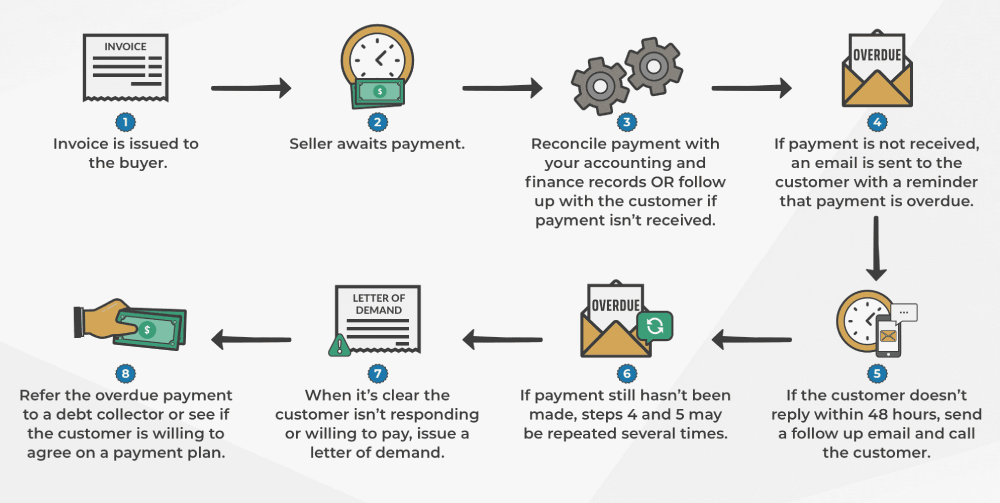Subscribe to our blog
Don’t miss the boat on digital debt collection
Published: July, 21st 2021

Chasing up late payments is something business owners and their finance and accounting teams spend a lot of time doing. And when following up late payments doesn’t work, it can be difficult for a business to meet its financial commitments. In fact, 27% of small businesses have been forced to take out loans to pay their suppliers and wages due to the cash flow crunch caused by late payments. While your current systems may help you to keep track of what’s overdue, the manual process of calling or emailing customers and making notes on each account is time consuming and costly.
Digitising your debt collection systems and processes can transform the way your business deals with late payments. In this article, we outline some of the key benefits of digitising debt collection in your business.
How do Australian businesses collect late payments?
The typical process an Australian business may take to follow up late payments looks a bit like this

It’s important to note that throughout these processes, many of the steps are manual and it’s not always clear if other people in your business have followed up the customer if your records aren’t kept updated at all times. Unfortunately, this can cause further tension with customers.
With long overdue debts, next steps may include an agreement on breaking the invoice into a payment plan of smaller instalments or issuing a letter of demand. While these manual processes may work in some instances, it requires a lot of the business’s resources. Further, if a customer has multiple overdue invoices, many accounting and finance systems don’t have the functionality to allow customers to pay several invoices in one transaction.
Digitising and automating debt collection
Payment solutions, such as Spenda, provides businesses with the ability to offer customers multiple flexible options that will not only result in faster payments, but it makes debt collection a breeze too. Differentiated by its ledger-to-ledger collaboration framework, Spenda’s technology ensures both parties are working from a single source of digital truth.
The integrated technology on which Spenda’s platform is built provides a range of features and functionality that transforms how businesses chase up late payments. Some of the key ways that Spenda makes debt collection easy are outlined below.
Better bill presentment
The software provides payment flexibility, lower transaction processing costs, faster settlement, multi-invoice payment and ledger-to-ledger integration. With the ability to view and schedule payments in an intuitive interface, the customer and supplier are connected ledger-to-ledger, allowing customers to select what invoices they pay and when. For overdue invoices, this provides an easy way for suppliers to work with a customer on paying down their debt. The payments can be scheduled in the time it takes for a short phone call, instead of chasing up a customer multiple times. And with an automated payment schedule, there’s no need to follow up the customer for each subsequent payment.
More payment options
Providing customers with a range of payment options increases your likelihood of getting paid on time. With Spenda, business customers have access to the convenience they’ve come to expect in B2C payments. Customers will enjoy options such as instant payments through our workflow payments feature (automated payments on goods or service delivery), credit card payments, bank transfers and buy now, pay later (BNPL) options. By offering credit card and BNPL options, your customers can effectively extend their credit terms while you get paid on time. Once a customer selects a payment option, they’ll also have the option to save it for future payments, saving more time on their next order or payment.
Real-time integration
Spenda’s software integrates seamlessly with Australia’s leading SME accounting platforms such as Xero, MYOB, Quickbooks Online and larger ERP management systems. This real-time integration reduces the manual data entry burden in businesses which mitigates data errors and helps the business realise efficiencies.
These features combined allow businesses to quickly and easily follow up late payments. Further, customers have the ability to easily set up a payment plan that works for them. Of course, with Spenda integrated in your business over time, the payment options available should reduce your instances of late payments in the first place.
Let’s take a look at an example:
Clean and Green Catering has several overdue accounts with the business currently owed almost $25,000. Rent on their commercial kitchen is due in two weeks and they need cash flow to prepare for their next busy season of events coming up in a month. Without getting these invoices paid, the business will have to try and find another business loan or, worse, have to cancel some of their upcoming jobs.
The business tries Spenda to see if they can get some of their customers to agree to a payment plan. Kate, the owner, sets aside a few hours one morning to call each overdue account and walk them through Spenda’s platform. In the space of a few hours, each customer has set up a payment plan for their invoices and Clean and Green Catering should have the full $25,000 in their account in the next four weeks. With this certainty and added visibility of the business’s cash flow, Kate has reduced the stress associated with these late payments and she can schedule her upcoming payments in alignment with when money will be flowing into her business. Now that Kate was able to sort out $25,000 in half a day, she’s going to put all of her customer’s orders and payments through Spenda’s platform.
Unlock cash flow with Spenda
With Spenda, businesses have the ability to realise faster payment times and digitise their debt collection process while providing a seamless experience to their customers.
If you’d like to see Spenda in action, why not book a demo with one of our payments experts? Alternatively, if you have any questions, send them over to our contact us page and our team will be more than happy to help you out.
*This article is for general information purposes only. Consult a qualified financial advisor regarding any changes to or decisions about your business’s finances.
